Greater Montreal
Greater Montreal is the most populous metropolitan area in Quebec and the second most populous in Canada after Greater Toronto. In 2015, Statistics Canada identified Montreal's Census Metropolitan Area (CMA) as 4,258.31 square kilometres (1,644.14 sq mi) with a population of 4,027,100.[3]
Greater Montreal Grand Montréal | |
|---|---|
| Montreal Metropolitan Community | |
 | |
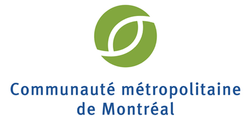 | |
| Country | Canada |
| Province | Quebec |
| Area | |
| • Land | 4,258.31 km2 (1,644.14 sq mi) |
| Population (2016)[2] | |
| • Total | 4,098,927 |
| • Density | 890.2/km2 (2,306/sq mi) |
| Time zone | UTC−05:00 (EST) |
| • Summer (DST) | UTC−04:00 (EDT) |
| Postal code prefixes | H, J |
| Area code(s) | 438, 450, 514, 579 |
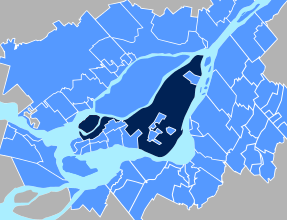 | |
A smaller area of 3,838 square kilometres (1,482 sq mi) is governed by the Montreal Metropolitan Community (MMC) (French: Communauté métropolitaine de Montréal, CMM). This level of government is headed by a president (currently Montreal mayor Valérie Plante).
The inner ring is composed of densely populated municipalities located in close proximity to Downtown Montreal. It includes the entire Island of Montreal, Laval, and the Urban Agglomeration of Longueuil.
The outer ring is composed of low-density municipalities located on the fringe of Metropolitan Montreal. Most of these cities and towns are semi-rural. Specifically, the term off-island suburbs refers to those suburbs that are located on the North Shore of the Mille-Îles River, those on the South Shore that were never included in the megacity of Longueuil, and those on the Vaudreuil-Soulanges Peninsula.
Due to their proximity to Montreal's downtown core, some suburbs on the South Shore (Longueuil, Brossard, Saint-Lambert, and Boucherville) are usually not included in the off-island suburbs even though they are on the mainland.
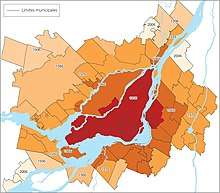
Largest cities
| Rank | City | Region | Population (2016) | Land Area | Population Density | ||
|---|---|---|---|---|---|---|---|
| km2 | mi2 | /km2 | /mi2 | ||||
| 1 | Montreal | Montreal | 1,704,694 | 365.13 | 140.98 | 4,662.1 | 12,075 |
| 2 | Laval | Laval | 422,993 | 247.09 | 95.40 | 1,710.9 | 4,431 |
| 3 | Longueuil | Montérégie | 239,700 | 115.59 | 44.63 | 2,070.9 | 5,364 |
| 4 | Terrebonne | Lanaudière | 111,575 | 154.12 | 59.51 | 723.9 | 1,875 |
| 5 | Brossard | Montérégie | 85,721 | 45.20 | 17.45 | 1,895.4 | 4,909 |
| 6 | Repentigny | Lanaudière | 84,285 | 61.79 | 23.86 | 1,376.5 | 3,565 |
| 7 | Saint-Jérôme | Laurentides | 74,346 | 90.52 | 34.95 | 822.1 | 2,129 |
| 8 | Blainville | Laurentides | 56,863 | 55.10 | 21.27 | 1,030.9 | 2,670 |
| 9 | Mirabel | Laurentides | 50,513 | 485.07 | 187.29 | 104.1 | 270 |
| 10 | Dollard-des-Ormeaux | Montreal | 48,899 | 14.97 | 5.78 | 3,266.1 | 8,459 |
Cities and towns
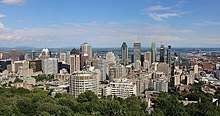 Montreal
Montreal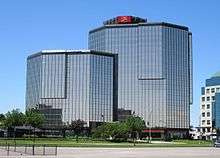 Laval
Laval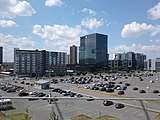 Longueuil
Longueuil
- subdivided into nineteen boroughs
- subdivided into the boroughs of Le Vieux-Longueuil, Saint-Hubert and Greenfield Park.
There are 82 municipalities that are part of the MMC and 91 municipalities that are part of the CMA. A total of 79 municipalities overlap between the two, with 3 municipalities being part of the MMC but not the CMA, and 12 municipalities being part of the CMA but not the MMC. Kanesatake and Kahnawake are not included in the previous counts.
Demographics
| Year | Pop. | ±% |
|---|---|---|
| 1871 | 174,090 | — |
| 1881 | 223,512 | +28.4% |
| 1891 | 308,169 | +37.9% |
| 1901 | 393,665 | +27.7% |
| 1911 | 594,812 | +51.1% |
| 1921 | 774,330 | +30.2% |
| 1931 | 1,064,448 | +37.5% |
| 1941 | 1,192,235 | +12.0% |
| 1951 | 1,539,308 | +29.1% |
| 1956 | 1,745,001 | +13.4% |
| 1961 | 2,110,679 | +21.0% |
| 1966 | 2,570,985 | +21.8% |
| 1971 | 2,743,208 | +6.7% |
| 1976 | 2,802,485 | +2.2% |
| 1981 | 2,862,286 | +2.1% |
| 1986 | 2,921,357 | +2.1% |
| 1991 | 3,208,970 | +9.8% |
| 1996 | 3,326,510 | +3.7% |
| 2001 | 3,426,350 | +3.0% |
| 2006 | 3,635,571 | +6.1% |
| 2011 | 3,824,221 | +5.2% |
| 2016 | 4,098,927 | +7.2% |
| [5] | ||
| Language | Greater Montreal | Quebec | Canada |
|---|---|---|---|
| French | 65.9% | 79.1% | 21.4% |
| English | 13.2% | 8.9% | 58.1% |
| Arabic | 4.5% | 2.1% | 1.1% |
| Spanish | 3.2% | 1.8% | 1.3% |
| Italian | 2.7% | 1.6% | 1.3% |
| Creole | 1.5% | 0.8% | 0.2% |
| Mandarin | 1.0% | 0.1% | 1.8% |
| Greek | 1.0% | 0.5% | 0.4% |
| Romanian | 0.8% | 0.4% | 0.3% |
| Portuguese | 0.8% | 0.5% | 0.7% |
| Russian | 0.7% | 0.3% | 0.5% |
| Vietnamese | 0.7% | 0.4% | 0.5% |
| Persian (Farsi) | 0.6% | 0.3% | 0.5% |
| Cantonese | 0.6% | 0.1% | 1.7% |
| Tagalog (Filipino) | 0.5% | 0.2% | 1.2% |
| Armenian | 0.4% | 0.2% | 0.1% |
| Tamil | 0.4% | 0.2% | 0.4% |
| Punjabi (Panjabi) | 0.3% | 0.2% | 1.4% |
| Polish | 0.3% | 0.2% | 0.6% |
| Bengali | 0.3% | 0.1% | 0.2% |
| German | 0.3% | 0.2% | 1.3% |
| Urdu | 0.3% | 0.1% | 0.6% |
| Yiddish | 0.2% | 0.1% | <0.1% |
| Cambodian (Khmer) | 0.2% | 0.1% | <0.1% |
| Turkish | 0.2% | 0.1% | 0.1% |
| Gujarati | 0.2% | 0.1% | 0.3% |
| Hungarian | 0.2% | 0.1% | 0.2% |
| Bulgarian | 0.2% | 0.1% | 0.1% |
| Berber (Kabyle) | 0.2% | 0.1% | <0.1% |
| Unspecified Chinese | <0.1% | 0.1% | 0.1% |
Transportation
Exo operates the region's commuter rail and metropolitan bus services, and is the second busiest such system in Canada after Toronto's GO Transit. Established in June 2007, Exo's commuter rail system has six lines linking the downtown core with communities as far west as Hudson, as Far south as Mont-Saint-Hilaire, as far east as Mascouche, and as far north as Saint-Jérôme.
Along with Exo, a sister agency, the Autorité régionale de transport métropolitain (ARTM) plans, integrates, and coordinates public transport across Greater Montreal, including the Island of Montreal, Laval (Île Jésus), and communities along both the north shore of the Rivière des Mille-Îles and the south shore of the Saint Lawrence River. The ARTM's mandate also includes the management of reserved High-occupancy vehicle lanes, metropolitan bus terminuses, park-and-ride lots, and a budget of $163 million, which is shared amongst the transit corporations and inter-municipal public transit organizations.
The Exo/ARTM's territory spans 63 municipalities and one native reserve, 13 regional county municipalities, and 21 transit authorities. It serves a population of approximately 3.7 million people who make more than 750,000 trips daily.
The major transit commissions under the ARTM are:
- Société de transport de Montréal (English: Montreal Transit Corporation), serving the Island of Montreal
- Société de transport de Laval (English: Laval Transit Corporation), serving the city of Laval
- Réseau de transport de Longueuil (English: Longueuil Transit Network), serving the Urban agglomeration of Longueuil
Education
| Universities | CEGEPs and other colleges | Other schools |
|---|---|---|
|
|
(In Montreal, except where otherwise noted.)
See also
Notes
- Group 1
- Only a portion of municipalities in the MRC are included in the MMC.
- Only a portion of municipalities in the MRC are included in the CMA.
- Group 2
- classified as an equivalent territory
- Group 3
- in area served by the Réseau de transport métropolitain
References
- "Census Profile - Montreal Census Metropolitan Area". Canada 2011 Census. Statistics Canada. 8 February 2012. Archived from the original on 15 January 2016. Retrieved 9 February 2012.
- "Population and dwelling counts, for census metropolitan areas, 2016 and 2011 censuses – 100% data". Statistics Canada. Government of Canada. Archived from the original on 11 February 2017. Retrieved 14 February 2017.
- "Grand Montréal: maintenant 4 millions de personnes". journalmetro.com. Archived from the original on 20 October 2017. Retrieved 30 April 2018.
- https://www12.statcan.gc.ca/census-recensement/2016/dp-pd/hlt-fst/pd-pl/Table.cfm?Lang=Eng&T=1601&CMA=462&S=94&O=A&RPP=25
- "Évolution de la population de Montréal, 1660 à nos jours". Ville de Montréal. Archived from the original on 11 November 2012. Retrieved 19 November 2013.
- "Montréal, CMA, Quebec". Canada 2011 Census. Statistics Canada. 4 August 2017. Retrieved 11 December 2019.
External links
- (in French) Metropolitan Community of Montreal website
- Act respecting the Communauté métropolitaine de Montréal (provincial statute)
- Greater Montreal Area Restaurants
- (in French) Greater Montreal Area map in .pdf
